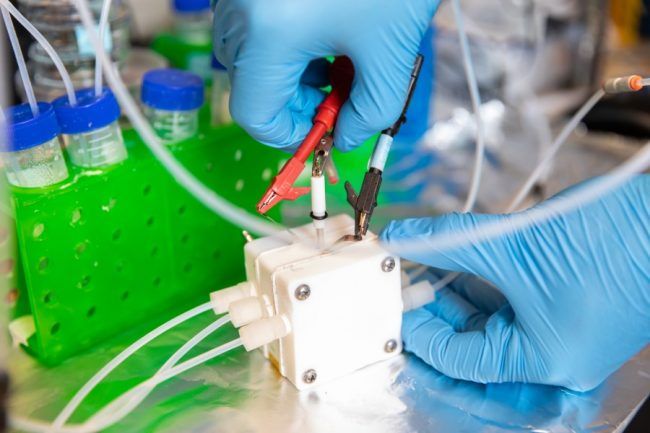Clean, renewable sources of energy are of utmost importance to meet the increasing worldwide demand. In particular, solar energy is a remarkably abundant source: the amount of sunlight hitting the earth’s surface in one hour is enough to satisfy humanity’s annual energy needs many times over. However, solar currently represents a minute portion of the current energy mix; reductions in materials and installation costs are required to accelerate adoption.
Perovskites
The rapid emergence of perovskites, a mixed organic-inorganic halide material, has accelerated progress in photovoltaics. Within ten years, the power conversion efficiency of single-junction perovskite solar cells has jumped from 3% to over 25% by leveraging excellent photophysical properties, such as low trap state density, long diffusion length, and high photoluminescence quantum efficiency.
Our work has unveiled the basic physical properties of perovskites and has advanced technologies to engineer optoelectronic devices with high performance. Our interests include solution-processed ABX3 (A=CH3NH3, Cs, B=Pb, X=I, Br, Cl), lattice strain, and composition inhomogeneity. We have explored trap density, carrier diffusion, and 3D/2.5D/2D perovskites in an efficient solar cell.
LSC
Luminescent solar concentrators (LSC) consist of luminescent chromophores embedded in a transparent waveguide. Broadband photons from incident sunlight are first absorbed by the chromophores and are then emitted at a longer wavelength. The emitted photons are waveguided to solar cells attached on the perimeter of the waveguide panel where they are converted to electrical power. This technology can play a role in building-integrated photovoltaics in view of control over the colour and transparency of LSC films. It is essential to maximize photoluminescence quantum efficiency (PLQY) of the chromophores to achieve high concentration factor of LSC, as well as a sufficiently large Stokes shift.
CQD
Colloidal quantum dots (CQDs) are nanometre-scale semiconductor particles synthesized in and processed from solution. This allows the use of CQD inks to be painted onto flexible substrates for rapid, low-cost fabrication of solar cells. Our interdisciplinary research on CQD solar cells spans theoretical modeling, materials design, and device engineering. Through these, we aim to advance the efficiency of low-cost CQD solar cells and have certified the first CQD cell with efficiency over 10%. Our continuing research includes investigating the role of surface ligands on CQD surfaces in determining electrical properties and device stability. We are also developing methods to make coating solar cells faster and cheaper, including by spraying CQDs on flexible substrates. By exploiting the infrared sensitivity of CQDs, we are exploring methods of augmenting other photovoltaic materials by absorbing otherwise wasted long-wavelength light.



